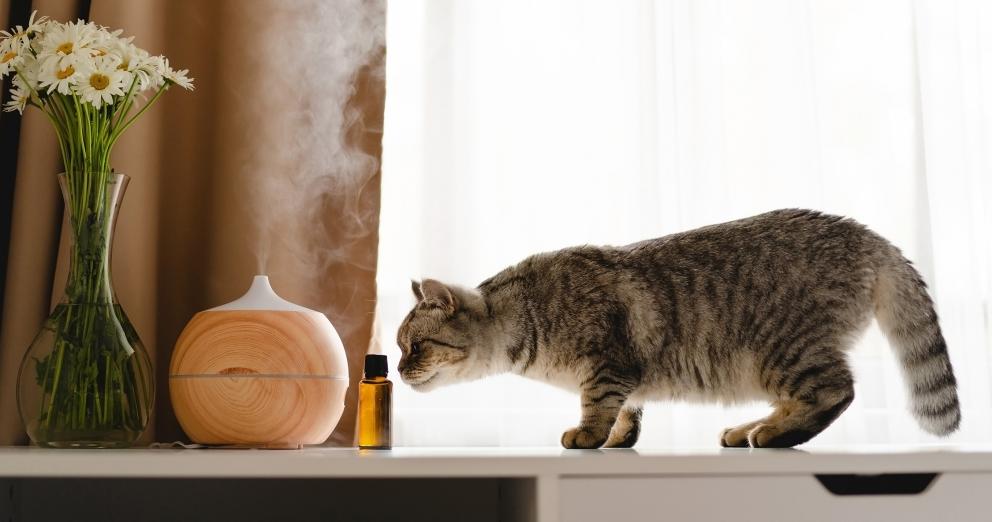You are here
Common Household Hazards: Poison Prevention Week

Our homes are filled with substances that, while harmless to humans, can be dangerous for our furry friends. In the spirit of “Poison prevention Week” this article aims to shed light on common household hazards for pets, focusing on dogs and cats, and offers guidance on prevention and recognizing symptoms of poisoning.
Batteries
Batteries, especially alkaline dry cell (e.g. AA, AAA) and button/disc batteries, pose a severe risk when ingested or chewed by pets. The acidic or alkaline material can leak out, causing corrosive injuries to the mouth, esophagus, and other tissues. Symptoms include drooling, oral pain, vomiting, and abdominal pain. Immediate veterinary attention is crucial to manage these potentially life-threatening injuries.
Topical Creams
Topical medications for humans, such as 5-fluorouracil (5-FU) and calcipotriene, can have fatal consequences for pets. These substances can cause severe gastrointestinal upset, seizures, bone marrow suppression, and even death in pets, particularly in cats, which are more susceptible due to their grooming habits.
Another example is calcipotriene, a treatment for psoriasis, that can lead to anorexia, vomiting, diarrhea, and potentially fatal hypercalcemia in dogs.
Pets can be exposed to these topical medications through licking treated areas, biting ointment tubes, or grooming fur that has come into contact with the creams. Remember, even small exposures can have serious consequences.
Essential Oils
Since diffusers have become a common household item, it's important to remember that essential oils can be toxic to pets, especially cats and birds, due to their sensitive metabolisms. Oils such as tea tree, peppermint, lavender, and citrus can cause symptoms ranging from drooling, vomiting, to difficulty breathing and liver damage. Pet owners should use essential oils cautiously and keep them out of reach of pets.
If you think your pet has ingested essential oils or is having a reaction to a diffuser, consult your veterinarian or visit an emergency veterinary clinic immediately.
Cannabis
Cannabis is toxic to pets and can lead to a range of symptoms from lethargy, disorientation, urinary incontinence, ataxia, hyperesthesia, difficulty breathing, and even death. To prevent accidental cannabis exposure, it is crucial to store cannabis products securely and out of reach of pets.
Pets can be exposed to cannabis in different ways, through ingesting edibles, raw cannabis, or even via second-hand smoke. If you suspect your pet has ingested or been exposed to cannabis, seek immediate veterinary attention.
Xylitol
Xylitol, a common sugar substitute found in sugar-free gum, tooth-paste, candies, and some peanut butters, is highly toxic to dogs. Ingestion can lead to a rapid release of insulin, resulting in hypoglycemia (low blood sugar), seizures, liver failure, and death. Symptoms can develop within 10 to 60 minutes after ingestion, making it critical to seek veterinary care immediately.
Spring Lilies
Spring flowers, particularly lilies, are a common household decoration to celebrate the season, but they are also a common source of poisoning in cats
For cats, even minimal contact with lilies can be life-threatening. Ingesting as few as one or two leaves or a small amount of pollen can cause severe symptoms, including vomiting, loss of appetite, lethargy, and dehydration, which can progress to kidney failure. To protect your pets, especially cats, from the dangers of lily poisoning, it's crucial to keep these plants out of reach or, better yet, avoid them altogether in homes and gardens where pets reside.
Chocolate
Chocolate poses a significant risk to pets, especially dogs and cats, due to its content of theobromine and caffeine. These substances, while easily metabolized by humans, are processed much more slowly in pets, leading to potentially fatal toxic accumulation. The severity of chocolate toxicity in pets depends on the type of chocolate, the amount ingested, and the size of the pet. Symptoms of chocolate toxicity in pets can include vomiting, diarrhea, rapid breathing, increased heart rate, lethargy, and seizures.
Prevention is Key
Prevention is key to keeping pets safe from household toxins. Store hazardous substances out of reach, use childproof locks on cabinets, and be mindful of what you leave within your pet's reach. Familiarize yourself with the symptoms of poisoning, which can include vomiting, diarrhea, drooling, lethargy, seizures, and sudden changes in behavior.
If you suspect your pet has ingested or been exposed to a toxic substance, contact your veterinarian or an emergency pet poison hotline immediately. Time is of the essence in these situations, and prompt veterinary care can make all the difference. By staying informed about common household hazards and practicing preventive measures, pet owners can ensure their furry family members remain safe and healthy.
Resources
Batteries Are Toxic To Pets | Pet Poison Helpline®
Effect of topical dermatologic medications in humans on household pets - PMC
Topical Creams and Pets: A Dangerous Combination | ASPCApro
Safety alert! The dangers of essential oils and pets - BC SPCA
Retrospective evaluation of xylitol ingestion in dogs
Summer Toxins to Avoid with Your Pet | VCA Canada Animal Hospitals
Easter Lilies | Pet Poison Helpline®
Cat Owners Beware: Lily Poisoning | Alberta Animal Health Source
Pet Owners Beware: Marijuana Is Toxic! | Alberta Animal Health Source
